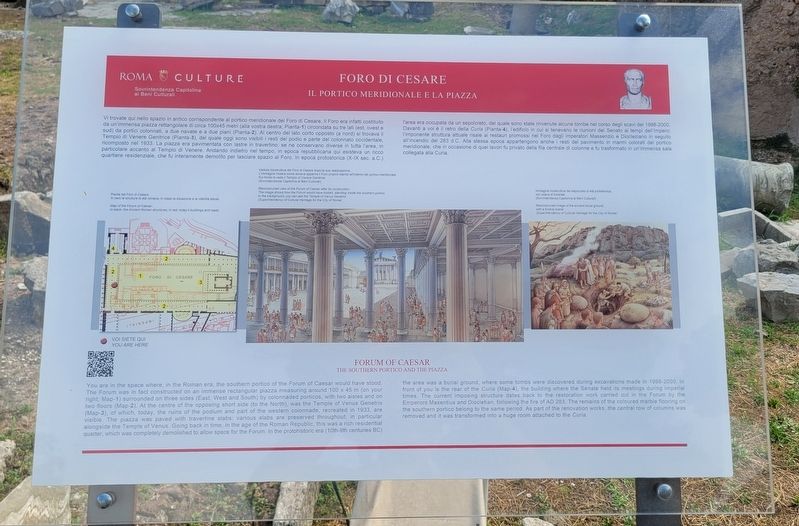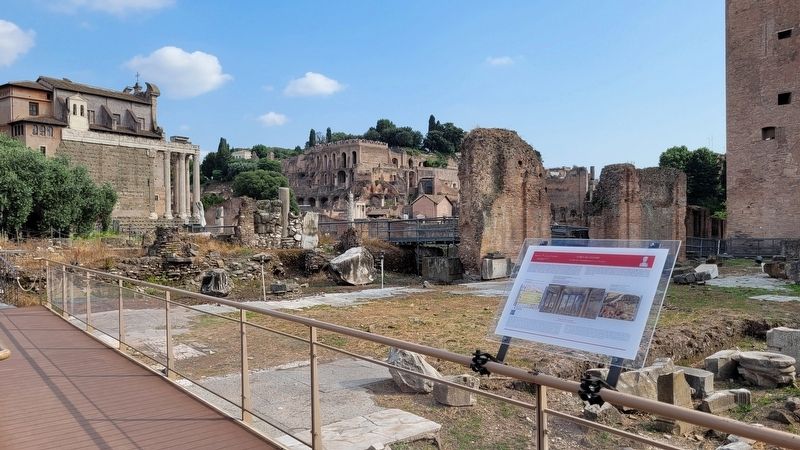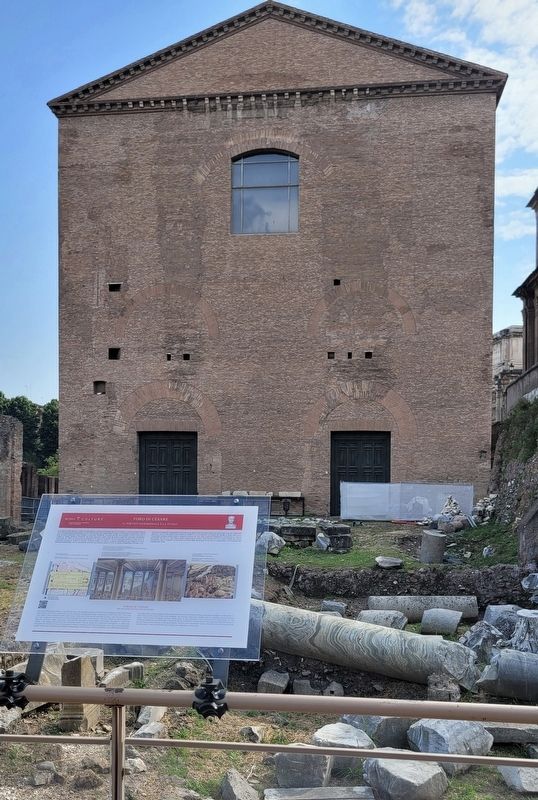Rione X Campitelli in Roma in Città metropolitana di Roma Capitale, Latium, Rome, Italy — Central Italy (Tyrrhenian Coast)
Foro di Cesare / Forum of Caesar
Il Portico Meridionale e la Piazza / The Southern Portico and the Piazza
Didascalie
Sinistra: Pianta del Foro di Cesare. In nero le strutture di età romana; in rosso la situazione e la viabilità attuali.
Centro: Veduta ricostruttiva del Foro di Cesare dopo la sua realizzazione. L'immagine mostra come doveva apparire il Foro proprio stando all'interno del portico meridionale. Sul fondo si vede il Tempio di Venere Genitrice (Sovrintendenza Capitolina al Beni Culturali)
Destro: Immagine ricostruttiva del sepolcreto di età protostarica, con scena di funerale (Sovrintendenza Capitolina al Beni Culturali)
You are in the space where, in the Roman era, the southern portico of the Forum of Caesar would have stood. The Forum was in fact constructed on an immense rectangular piazza measuring around 100 x 45 m (on your right; Map-1) surrounded on three sides (East, West and South) by colonnaded porticos, with two aisles and on two floors (Map-2). At the centre of the opposing short side (to the North), was the Temple of Venus Genetrix
(Map-3), of which, today, the ruins of the podium and part of the western colonnade, recreated in 1933, are visible. The piazza was paved with travertine slabs; various slabs are preserved throughout, in particular alongside the Temple of Venus. Going back in time, in the age of the Roman Republic, this was a rich residential quarter, which was completely demolished to allow space for the Forum. In the protohistoric era (10th-9th centuries BC) the area was a burial ground, where some tombs were discovered during excavations made in 1998-2000. In front of you is the rear of the Curia (Map-4), the building where the Senate held its meetings during Imperial times. The current imposing structure dates back to the restoration work carried out in the Forum by the Emperors Maxentius and Diocletian, following the fire of AD 283. The remains of the coloured marble flooring on the southern portico belong to the same period. As part of the renovation works, the central row of columns was removed and it was transformed into a huge room attached to the Curia.
Captions
Left: Map of the Forum of Caesar. In black: the Ancient Roman structures; in red: today's buildings and roads.
Center: Reconstructed view of the Forum of Caesar after its construction. The image shows how the Forum would have looked, standing inside the southern
portico. In the background, you can see the Temple of Venus Genetrix (Superintendency of Cultural Heritage for the City of Rome)
Right: Reconstructed image of the ancient burial ground, with a funeral scene (Superintendency of Cultural Heritage for the City of Rome)
Erected by Roma Culture and Sovrintendenza Capitolina ai Beni Culturali.
Topics. This historical marker is listed in these topic lists: Anthropology & Archaeology • Architecture. A significant historical year for this entry is 283 CE.
Location. 41° 53.6′ N, 12° 29.151′ E. Marker is in Roma, Lazio (Latium, Rome), in Città metropolitana di Roma Capitale. It is in Rione X Campitelli. Marker is on Via dei Fori Imperiali, 0.1 kilometers north of L.go della Salara Vecchia. The marker is located along the pathway northwest of the Largo Romolo e Remo. Touch for map. Marker is in this post office area: Roma, Lazio 00186, Italy. Touch for directions.
Other nearby markers. At least 8 other markers are within walking distance of this marker. Foro di Nerva / Forum of Nerva (within shouting distance of this marker); Basi Marmoree / Marble Bases (within shouting distance of this marker); a different marker also named Foro di Cesare / Forum of Caesar (within shouting distance of this marker); Basilica Aemilia (within shouting distance of this marker); Shrine of Venus Cloacina / Sacello di Venere Cloacina (about 90 meters away, measured in a direct line); Il Pavimento in Opus Sectile Della / The Opus Sectile Marble Floor (about 90 meters away); Basilica Aemilia Entablature / Trabeazione (about 120 meters away); Forum Square (about 120 meters away). Touch for a list and map of all markers in Roma.
More about this marker. The marker is located in the Parco Archeologico del Colosseo (Roman Forum Archaeological Park) and it does require an entry fee to visit.
Also see . . .
1. Il Foro di Cesare. Roma Culture and Sovrintendenza Capitolina ai Beni Culturali (Submitted on November 24, 2023, by James Hulse of Medina, Texas.)
2. Forum of Caesar. Wikipedia
Caesar decided to construct a forum bearing his name in the northeast section of the Forum Romanum, and purchased some very expensive parcels of land in that area (the final cost was said to be 100,000,000 sesterces). Forum construction began probably in 51 BC, although Cicero and Gaius Oppius were entrusted with purchasing the parcels of land on Caesar's behalf as early as 54 BC. On the eve of the Battle of Pharsalus in 48, Caesar vowed a temple to Venus Victrix, the legendary progenitor of his own clan, the gens Iulia. This original dedication was done because she was Pompey's favourite goddess, and Caesar hoped to gain the goddess's favour before the battle against Pompey.(Submitted on November 24, 2023, by James Hulse of Medina, Texas.)
Credits. This page was last revised on December 18, 2023. It was originally submitted on November 23, 2023, by James Hulse of Medina, Texas. This page has been viewed 52 times since then and 14 times this year. Photos: 1, 2, 3. submitted on November 25, 2023, by James Hulse of Medina, Texas.


